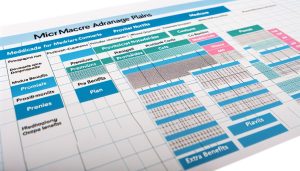
by Russell Noga | Updated January 27th, 2024
As the leaves turn and autumn sets in, it’s time to prepare for Medicare’s Open Enrollment. This annual event, crucial for anyone enrolled in Medicare, is your opportunity to review your coverage and make changes if necessary.
This year, however, Medicare’s landscape is undergoing notable changes due to key reforms taking place in 2025. Are you ready to navigate these changes when is open enrollment for Medicare 2025?
Key Takeaways
- Open Enrollment for Medicare 2025 is October 15th, December 7th.
- Special Enrollment Periods are available based on certain life events and can be applied for through the Social Security Administration’s website.
- Utilize resources such as personalized counseling and online tools to make an informed decision about coverage during Open Enrollment.
Key Dates for Medicare 2025 Open Enrollment

Mark your calendars, Medicare beneficiaries! The annual Medicare open enrollment period for 2025 will take place from October 15th to December 7th.
This period is the time for individuals to make changes to their existing Medicare coverage. This is your window to:
- Review, adjust, or switch your Medicare coverage, including your Medicare Advantage and Medicare Part D prescription drug plans.
- Transition from traditional Medicare to a Medicare Advantage plan or vice versa.
- Switch between Medicare Advantage plans.
- Select or transition between Medicare Part D prescription drug plans.
Whether you’re looking to make any of these changes, this is your time to do so.
You should closely monitor any changes to your existing plan during this period. Changes might include adjustments to your coverage, such as the inclusion or exclusion of certain services or shifts in the network of providers.
Remember, your healthcare needs may change over time, and the Medicare program is designed to adapt and provide the coverage that suits you best.
The Countdown Begins
Early October marks the onset of the countdown to open enrollment. It’s when you’ll start receiving crucial updates about your present Medicare plans and potential changes for the forthcoming year.
This information will provide a roadmap to guide your decision-making process during open enrollment. Whether it’s a change in premiums, adjustments to the services covered, or shifts in your plan’s network of providers, being aware of these changes will help you make an informed decision about whether your current plan is still the best fit for you.
Keep in mind, that the opportunity to make changes starts on October 15th and ends on December 7th. That’s when you can make changes to your Medicare coverage, including:
- shifting from traditional Medicare to a Medicare Advantage plan or vice versa
- switching between Medicare Advantage plans
- selecting or transitioning between Medicare Part D prescription drug plans
So, get ready, get set, and prepare to make the most of this opportunity!
Final Call for Changes
The final call for changes during the open enrollment period is December 7th. As this deadline approaches, it’s time to finalize any changes to your Medicare coverage.
Miss this deadline, and you may find yourself automatically reenrolled in your current plan, possibly with price adjustments. Not only that, but you might also limit your ability to make changes until the next open enrollment period or a special enrollment period if you qualify.
As the final call for changes approaches, you should:
- Reassess your existing Medicare coverage
- Consider other plans
- Account for changes in health needs
- Evaluate costs
- Verify provider networks
- Appreciate the importance of the enrollment deadline
If you need to make adjustments to your Medicare health plan or prescription drug coverage, make sure you do so before the deadline. If you miss it, you won’t be able to make changes until the next open enrollment period or if you qualify for a special enrollment period due to life-changing events.
Discover 2025 Plans & Rates
Enter Zip Code
Navigating Your Coverage Options During Open Enrollment

While exploring coverage options during open enrollment may seem challenging, it need not be overwhelming. Armed with the right knowledge and tools, you can confidently assess your options and make the best choice for your healthcare needs.
This includes exploring shifts in Medicare Advantage and drug plans and adjusting your prescription drug plan to ensure the best coverage and cost options for you.
Medicare Advantage differs from traditional Medicare in a few key ways.
While traditional Medicare is offered by the federal government and covers medically necessary services and supplies in hospitals, doctors’ offices, and other healthcare facilities, Medicare Advantage is provided by private insurance companies and includes all the benefits of original Medicare, plus extra benefits like prescription drug coverage, dental, vision, and hearing services. Comprehending these variations is key to making a well-informed choice about your Medicare coverage.
Exploring Medicare Advantage and Drug Plan Shifts
Choosing a Medicare Advantage plan requires careful consideration of potential changes that may affect your coverage and costs. For 2025, anticipated modifications in Medicare Advantage plans include the introduction of a $2,000 out-of-pocket spending cap, the elimination of the coverage gap phase, and an increased share of drug costs borne by enrollees.
In addition to these changes, other factors to consider when evaluating various Medicare Advantage plans include:
- Coverage
- Cost
- Network
- Prescription drug coverage
- Quality and ratings
- Additional benefits
With the introduction of a $2,000 cap on out-of-pocket drug costs for Part D enrollees starting in 2025, it’s more important than ever to assess the cost of Medicare Advantage and drug plans.
Adjusting Your Prescription Drug Plan
As your prescription drug needs evolve over time, open enrollment provides a chance to modify your prescription drug plan to suit these changes. Whether you’re taking new medications or your current plan’s formulary (the list of covered drugs) has changed, it’s important to review your current plan and compare other available options.
When assessing your current prescription drug needs, review your current medications, check your Medicare plan’s formulary, compare your medications to the formulary, consider your future medication needs, evaluate your out-of-pocket costs, and consult with your healthcare provider.
As you make adjustments to your Prescription Drug Plan, remember to consider patient-specific factors, coverage and formulary, cost, healthcare needs, preferred pharmacies, provider reputation, and Medicare regulations.
Special Enrollment Periods: Exceptions to the Rule
Although the open enrollment period annually offers a specific timeframe to alter your Medicare coverage, certain circumstances may permit changes outside this period.
These exceptions, known as special enrollment periods, provide an opportunity to adjust your coverage based on specific life events such as:
- turning 65
- losing employer coverage
- moving out of your plan’s service area
- qualifying for Medicaid
To seek a special enrollment period, navigate to the Medicare page on the Social Security Administration’s website and adhere to the instructions for enrollment in the Medicare segment you are eligible for.
It’s important to remember that these special enrollment periods are exceptions to the standard rules, and the specific instances in which you may qualify include:
- The eight-month period following the end of group health plan coverage or employment
- The Special Enrollment Period (SEP) for exceptional circumstances
- The Initial Enrollment Period (IEP), is a seven-month window when you are first eligible for Medicare.
Qualifying Life Events
Qualifying life events that make you eligible for a special enrollment period include:
- reaching the age of 65
- experiencing loss of employer coverage
- moving outside of your plan’s service area
- gaining or losing Medicaid
It’s important to note that a change in residence does not impact Medicare eligibility, as Medicare is a federal healthcare program, and moving from one state to another does not alter the basic benefits provided by original Medicare.
If you lose your employer-sponsored health coverage, you generally have an eight-month window to register for Medicare. Furthermore, qualifying for special enrollment based on eligibility for Medicare Savings Programs is contingent upon meeting the income and asset limits established by your state and having at least Medicare Part A coverage.
How to Apply for Special Enrollment
If you’ve experienced a qualifying life event and are eligible for special enrollment, you can apply by visiting the Social Security Administration’s Medicare page and following the instructions to enroll in the part of Medicare for which you’re eligible.
To apply, you’ll need to provide evidence of age, U.S. citizenship or legal residency, your Social Security number, evidence of income, and evidence of current health insurance.
While the duration of the special enrollment application process can vary, it’s advisable to submit your application at least three months before your desired start date of coverage. Keep in mind that, under urgent circumstances, the special enrollment application for Medicare can be expedited to accommodate pressing needs.
Understanding Medicare Advantage Plan Variations

Grasping the differences in Medicare Advantage plans is vital for a well-informed decision regarding your health coverage. Medicare Advantage plans are provided by private insurance companies and offer a range of plan types, including:
- HMO
- PPO
- MSA
- PFFS
These plans combine all the benefits of original Medicare, and often include additional benefits, into a single plan.
When comparing premiums for different Medicare Advantage plans, you can use tools like the Medicare Plan Finder on Medicare.gov or websites like eHealthInsurance.com and Humana.com. These resources provide details on the costs and benefits of different plans.
In addition to premiums, it’s also important to consider other out-of-pocket costs, such as deductibles and copayments, when evaluating plans.
Compare Plans Carefully
When evaluating different Medicare Advantage plans, it’s important to consider factors such as coverage, cost, network, prescription drug coverage, quality and ratings, and additional benefits.
For 2025, anticipated significant modifications in Medicare Advantage plans include the introduction of a $2,000 out-of-pocket spending cap, the elimination of the coverage gap phase, and an increased share of drug costs borne by enrollees.
In addition to these changes, it’s also important to consider other factors when choosing a health insurance plan, such as:
- The specific benefits provided by each plan
- The provider network
- The cost-sharing requirements
- Any restrictions or limitations
By carefully comparing plans, you can ensure that you choose the one that best meets your healthcare needs and budget.
Prescription Drug Coverage Under Medicare Advantage
Prescription drug coverage is a critical component of Medicare Advantage plans, but the specific coverage can vary from plan to plan. This can include differences in the specific drugs covered, the cost-sharing requirements, and the network of pharmacies where you can fill your prescriptions.
The drugs covered by a Medicare Advantage drug plan are listed in a formulary, which includes both generic and brand-name prescription drugs. Each Medicare Advantage plan has the discretion to determine the specific drugs covered within each drug category.
It’s important to review the formulary for each plan you’re considering to ensure it covers the medications you need.
Remember, the list of covered drugs can change annually, so it’s important to review your plan’s formulary each year during open enrollment.
Preparing for Changes: The Inflation Reduction Act’s Impact on Medicare

The Inflation Reduction Act introduces substantial modifications to Medicare, particularly in the area of prescription drug coverage. Starting in 2025, the act includes the following changes:
- A cap of approximately $3,250 for all Medicare Part D drug expenses, which will begin in 2024
- An annual limit of $2,000 for out-of-pocket costs related to prescription drugs
- The requirement for beneficiaries to share five percent of prescription costs during the catastrophic phase of Part D will be phased out by 2025.
These changes aim to reduce the financial burden on Medicare beneficiaries for prescription drug expenses.
In addition to these changes, beginning in 2023, adult vaccines recommended by the CDC, such as the influenza vaccination, and other preventive services will be covered with zero-dollar cost-sharing under Medicare Part D and Medicare Advantage plans.
These changes, brought about by the Inflation Reduction Act, aim to make Medicare more affordable and accessible for beneficiaries.
Prescription Drug Cost Caps and Their Effect
The prescription drug cost caps introduced by the Inflation Reduction Act will significantly impact out-of-pocket expenses for beneficiaries. Starting in 2025, there will be a $2,000 annual limit on prescription drug costs.
This cap will be adjusted in subsequent years in accordance with the rise in per capita Part D spending, which will help contain beneficiaries’ prescription drug expenses over time.
These caps restrict the amount beneficiaries are required to pay for their prescription drugs within a specified year. When an enrollee’s spending reaches $2,000 in a calendar year, they transition into the catastrophic coverage phase, which significantly decreases their cost-sharing.
This change could mean substantial savings for beneficiaries, especially those with high prescription drug costs.
Adult Vaccines and Preventive Services Without Cost-Sharing
Starting in 2023, adult vaccines recommended by the CDC and other preventive services will be covered with zero-dollar cost-sharing under Medicare Part D and Medicare Advantage plans. This change will enhance access to these crucial health services, improve health outcomes, and reduce socioeconomic disparities in healthcare among Medicare beneficiaries.
The process for implementing this policy will begin on January 1, 2023, and will be implemented in Medicare Part D and Medicare Advantage plans. Beneficiaries can expect to see changes such as the removal of cost-sharing for recommended vaccines, enhanced access to preventive services, and an annual limit on out-of-pocket prescription drug expenses.
Maximizing Benefits with Medicare Savings Programs
For beneficiaries with low income, Medicare Savings Programs offer extra support. These programs, which include the Qualified Medicare Beneficiary (QMB) Program, the Specified Low-Income Medicare Beneficiary (SLMB) Program, and the Qualified Individual (QI) Program, can help cover the costs of Medicare premiums, deductibles, copayments, and coinsurance.
The Extra Help program, also known as the low-income subsidy, is another resource for beneficiaries with limited income and resources. This program provides financial assistance for monthly premiums, annual deductibles, and copayments associated with Medicare prescription drug coverage.
To apply for these programs, beneficiaries should check their state’s income guidelines, gather their documents, and submit their application.
These programs, including Medicaid services, can help beneficiaries maximize their benefits and reduce their out-of-pocket healthcare costs.
Resources and Assistance for Making an Informed Decision
Though maneuvering through the Medicare landscape might be intricate, various resources are at your disposal to assist you. State Health Insurance Assistance Programs (SHIPs) provide personalized health insurance counseling for Medicare beneficiaries, helping them understand the Medicare system and select the health insurance options that best meet their needs.
In addition to personalized counseling, online tools like the Medicare Plan Compare website and the 1-800-MEDICARE helpline provide valuable resources for reviewing and comparing Medicare plans. By leveraging these resources and seeking assistance when needed, you can feel confident in your ability to make informed decisions about your Medicare coverage.
Personalized Health Insurance Counseling
State Health Insurance Assistance Programs (SHIPs) offer personalized health insurance counseling, aiding you in understanding the Medicare system and choosing the most suitable health insurance options. There is no formal application process for SHIP; simply reach out to your local SHIP to be connected with a counselor.
During counseling sessions, SHIP can help you understand a range of topics, including:
- Medicare coverage for mental health services
- Preventive services
- Home health services
- Skilled nursing facility care
- Medical coverage for specific conditions or treatments
Whether you’re new to Medicare, considering a change in coverage, or have questions about your current plan, SHIP can provide the personalized support you need.
Utilizing Online Tools to Compare Plans
Online tools prove to be a valuable resource in comparing Medicare plans. The Medicare Plan Compare website, also known as the Medicare Plan Finder, allows you to compare Medicare Advantage plan benefits, prescription drug coverage, and costs.
To use this tool, you’ll need to provide the following information:
- Your zip code
- Your Medicare number
- A list of your current prescription drugs and dosages
- Your preferred pharmacy, if applicable.
In addition to the Plan Compare website, you can also call 1-800-MEDICARE for personalized support in evaluating and comparing Medicare plans. Whether you prefer to research online or speak with someone directly, these resources can help you make an informed decision about your Medicare coverage.
Summary
In conclusion, the Medicare open enrollment period provides a crucial opportunity for beneficiaries to review and adjust their coverage.
Whether you’re exploring Medicare Advantage and drug plan shifts, adjusting your prescription drug plan, or qualifying for special enrollment periods, being informed about the Medicare 2025 reforms is essential.
Remember, resources like personalized health insurance counseling and online tools are available to assist you in making the best decision for your health care needs.
Compare Plans & Rates
Enter Zip Code
Frequently Asked Questions
What are the changes for Medicare in 2025?
In 2025, Medicare Part D will introduce an annual limit that caps out-of-pocket prescription drug costs at $2,000. Subsequent years will see the annual limit adjusted to account for inflation. This cap does not apply to out-of-pocket spending on Part B drugs.
What is the Medicare enrollment period for 2025?
Medicare’s Open Enrollment Period for 2025 is from October 15 to December 7, giving those with Medicare the opportunity to make changes to their coverage beginning January 1, 2025. Don’t delay, this period ends on December 7.
What changes can I make during the open enrollment period?
During open enrollment, you can make changes to your Medicare plan by transitioning from traditional Medicare to a Medicare Advantage plan or vice versa, switching between Medicare Advantage plans, or selecting or transitioning between Medicare Part D prescription drug plans.
What are Medicare Advantage plans, and how do they differ from traditional Medicare?
Medicare Advantage plans, provided by private insurance companies, including the same benefits as traditional Medicare and additional benefits like prescription drug coverage, and dental, vision, and hearing services. Traditional Medicare is offered by the federal government and covers medically necessary services and supplies.
Find the Right Medicare Plan for You
Finding the right Medicare Plan in 2024 doesn’t have to be confusing. Whether it’s a Medigap plan, or you want to know more about Medicare Open Enrollment, we can help.
Call us today at 1-888-891-0229 and one of our knowledgeable, licensed insurance agents will be happy to assist you!




